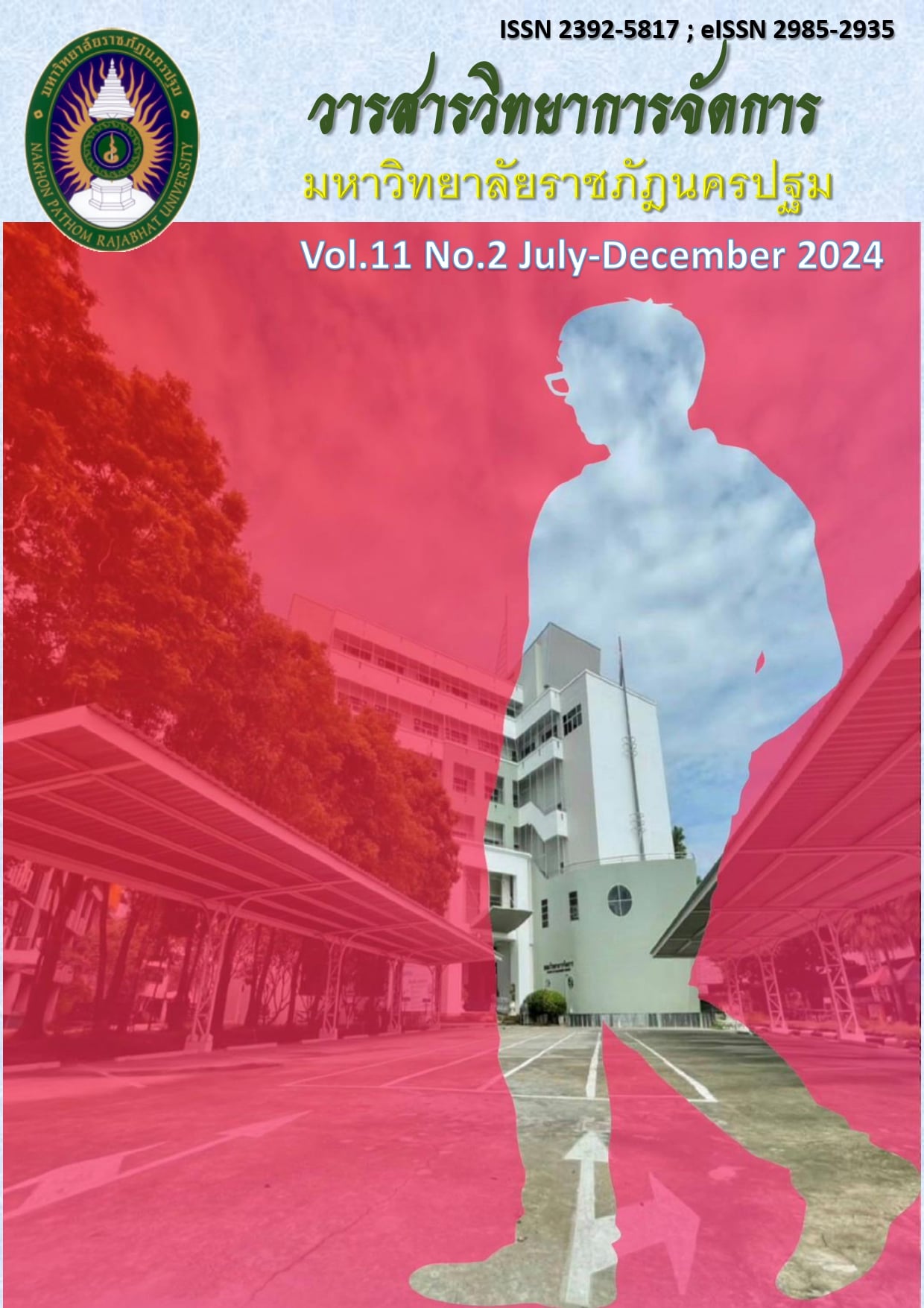The Development of Cultural, Traditional, and Historical Tourism Destinations, as Well as Natural Tourist Attractions Case study: Sung Noen District, Nakhon Ratchasima Province
Main Article Content
Abstract
Research on the development of cultural, traditional, and historical tourism destinations, as well as natural tourist attractions Case study: Sung Noen District, Nakhon Ratchasima Province, has the following objectives: 1) to study the current situation in Sung Noen District, Nakhon Ratchasima Province, regarding cultural, traditional, and historical tourism destinations, as well as natural tourist attractions that are to be developed and promoted; 2) to examine local development efforts aimed at establishing cultural, traditional, and historical tourism destinations, along with natural tourist attractions in Sung Noen District, Nakhon Ratchasima Province; and 3) to identify the problems, obstacles, and potential solutions. The research used qualitative methods, with data collected through in-depth interviews with 15 government agencies, 5 private sector organizations, and focus groups consisting of 12 community leaders.
The research found that:
1. The current situation in Sung Noen District, Nakhon Ratchasima Province, includes rich and interesting cultural, traditional, historical, and natural resources. In terms of ancient history, local culture, and traditions, these are well preserved. The natural resources, including waterfalls and extensive forests, remain intact, in part due to the presence of forest temples in the area, which contribute to the preservation of these resources.
2. The local community continues to preserve and promote these cultural and natural resources. In terms of development, efforts have been made to identify key tourist attractions in tangible forms while also fostering pride and a sense of shared ownership among residents. Initiatives to instill love and pride in local wisdom and cultural heritage are ongoing. Additionally, the community provides essential tourism services, including food, accommodation, safety measures, and access to tourism activities. There are also opportunities for community participation in tourism management, along with support for promoting knowledge to help residents understand the significance of local tourist attractions.
3. As for the development problem, it was found that most activities are carried out by the elderly, who work together within the community. However, there is a lack of involvement from younger members of the community. Additionally, an obstacle is that local agencies play a limited role in the care and development of certain sites, as some ancient landmarks, such as Wat Thammachakra Sema Ram, are already under the care of the Fine Arts Department. This results in limited community participation and cooperation in development efforts. Development guidelines A forum should be organized to present the drive towards creating a network of cooperation among various communities, groups of people, citizens, academics, and local philosophers. Local politicians and others to work together to solve problems in the area along with driving Developing the local area to be a cultural, traditional, historical and natural tourist destination in Sung Noen District, Nakhon Ratchasima Province. continue to be sustainable.
Article history: Received 10 August 2024
Revised 8 October 2024
Accepted 11 October 2024
SIMILARITY INDEX = 13.91
Article Details

This work is licensed under a Creative Commons Attribution-NonCommercial-NoDerivatives 4.0 International License.
The views and opinions of the article appearing in this journal are those of the author. It is not considered a view and responsibility of the editorial staff.
References
จิตนภา สมบูรณ์ศิลป์ กองแก้ว สิทธิศรี ขวัญชนก รักษาสุวรรณ พริศรา ภาวจันทึก ลักษมี แก้วบัว และ ศราดา หลายวิจิตรไพบูลย์ (2567). แนวทางการส่งเสริมการท่องเที่ยวเชิงวัฒนธรรมโดยการมีส่วนร่วมของชุมชน กรณีศึกษา วัดธรรมจักรเสมาราม อำเภอสูงเนิน จังหวัดนครราชสีมา. [ออนไลน์] ค้นเมื่อ
สิงหาคม 2567, จาก http://sutlib2.sut.ac.th/nakhonchaiburin/nm177182.pdf
ไทยรัฐออนไลน์. (2567). เจาะลึกอุตสาหกรรมท่องเที่ยวไทย ทำอย่างไรถึงสามารถก้าวสู่ความสำเร็จของคำว่า ‘เที่ยวยั่งยืน’. [ออนไลน์] ค้นเมื่อ 1 สิงหาคม 2567 จาก https://www.thairath.co.th/lifestyle/travel/thaitravel/2801946
ประกาศเทศบาลสูงเนิน. (2564). แผนพัฒนาท้องถิ่น (พ.ศ.2566 – 2570) เทศบาลตำบลสูงเนิน อำเภอสูงเนิน จังหวัดนครราชสีมา. เทศบาลสูงเนิน, จังหวัดนครราชสีมา
ประกาศ ยุทธศาสตร์ชาติ. (พ.ศ. 2561 – 2580) ราชกิจจานุเบกษา เล่ม 135 ตอนที่ 82 ก หน้า 9
สถาบันการท่องเที่ยวโดยชุมชน. (2560). สถาบันการท่องเที่ยวโดยชุมชน : CBT-I. [ออนไลน์] ค้นเมื่อ 1 สิงหาคม 2567 จาก https://www.facebook.com/cbticlub/photos/
a.156578091074830/1465062736893019/
Albrecht, K. (1987). The Creative Corporation. New York: Richard d Irwin;
Arshad, S., & Khurram, S. (2020). Can government’s presence on social media stimulate citizens’ online political participation? Investigating the influence of transparency, trust, and responsiveness. Government Information Quarterly, 37(3), 101486.
Bere, M. Y., Nursalam, N., & Toda, H. (2020). Social participation in the management of village funds in Sanleo village, East Malaka sub-district, Malaka regency. Annals of Management and Organization Research, 2(2), 81-96.
Goeldner, C., & Ritchie, J. R. B. (2006). Tourism: principles, practices, philosophies (10th ed.). Hoboken: Wiley.
Johnson, D. W., & Johnson, F. D. (2003). Joining: Group theory and group skill (8th ed.). Boston: Allyn andBacon.
Lewicki, R. J., Saunders, D. M., & Barry, B. (2006). Negotiation (5th ed.). Boston, MA McGraw-Hill.
Li, J. Y., Sun, R., Tao, W., & Lee, Y. (2021). Employee coping with organizational change in the face of a pandemic: The role of transparent internal communication. Public relations review, 47(1), 101984.
Morris, C. (2004). Managing conflict in health care settings: principles, practices & policies. Bangkok, Thailand: Prepared for a workshop at King Prajadhikop’s Institute.
Quick, K. S., & Bryson, J. M. (2022). Public participation. In Handbook on theories of governance (pp. 158-168). Edward Elgar Publishing.
Rose, K. M., Markowitz, E. M., & Brossard, D. (2020). Scientists’ incentives and attitudes toward public communication. Proceedings of the National Academy of Sciences, 117(3), 1274-1276.
Rus, M., Tasente, T., Iscru, A. M., & Sandu, M. L. (2022). Strategies and specific techniques to mass-media relations activities in a public institution. Technium Soc. Sci. J., 28, 273.
Shachar, R., & Nalebuff, B. (1999). Follow the leader: Theory and evidence on political participation. American Economic Review, 89(3), 525-547.
Stern, P. C., & Dietz, T. (Eds.). (2008). Public participation in environmental assessment and decision making. National Academies Press.
Thipkong, S. (2002). Curriculum and teaching of mathematics. Academic Quality Development Company. Co., Ltd. [in thai]
UNWTO. (1997). Tourism 2020 Vision. Madrid: UNWTO.
Vespestad, M. K., & Mehmetoglu, M. (2010). The relationship between tourist nationality,
cultural orientation and nature-based tourism experiences. European journal of
tourism research, 3(2), 87-104.
Zhang, J., Chen, W., Petrovsky, N., & Walker, R. M. (2022). The expectancy‐disconfirmation
model and citizen satisfaction with public services: A meta‐analysis and an agenda
for best practice. Public Administration Review, 82(1), 147-159.


